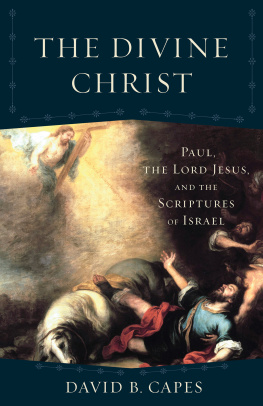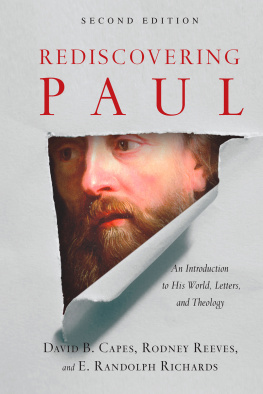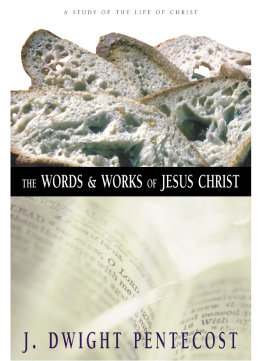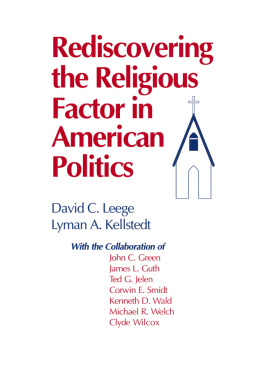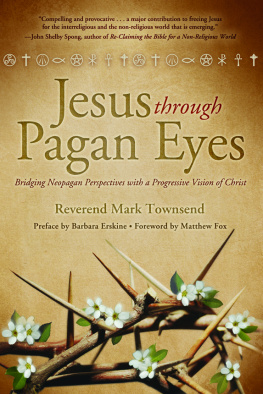To our students
who want answers to questions
scholars tend to ignore
CONTENTS
PREFACE
S ince many have undertaken to set down an orderly account (as Luke noted in his preface long ago), why add another? There are a lot of great textbooks on Jesus. We are particularly keen on the ones by Mark Strauss, Bruce Fisk, Darrell Bock and Craig Blomberg. As teachers, though, we found that our students often asked questions these books did not address. Whether spurred by Dan Browns The Da Vinci Code, a headline spied on a grocery store tabloid, or a thoughtful documentary on The History Channel, inquiring minds want to know. We decided to write a textbook with a different approach to complement these other works.
We begin by looking at the biblical Jesus. We examine Marks Jesus and each of the other three Gospel portraits, allowing each Gospel writer to tell his own story of Jesus. Then each section of the New Testament is allowed to describe its portrait of Jesus, whether Paul, Hebrews, the General Epistles or Revelation. In the second half of the book we look at some images of Jesus outside the New Testament that have been formative to our modern Western view of him. The Gnostic Jesus, the Muslim Jesus, the Jesus of the Enlightenment, the Mormon Jesus, even the American Jesus and the Jesus of filmeach is given a voice. Although we do not believe that these extrabiblical voices are authoritative, they have influenced how all of us see Jesus. When we look back to the New Testament, we often look through rather than around these images of Jesus. Rediscovering Jesus requires hearing all the voices that have colored our perceptions of him.
Each chapter has three parts. First, we ask what a particular picture of Jesus looks like. We play off Jesus question at Caesarea Philippi when he asked his disciples, Who do people say that I am? This is still a very important question. So, for example, we ask, Who does Mark say that Jesus is? Who does Revelation say that he is? Who do the Mormons say that he is? Second, each chapter will ask how this picture of Jesus is different. What are the distinctives of Marks Jesus? How is the picture of Jesus in Hebrews different? We try to highlight the more unique elements and emphases that this portrait of Jesus contains. Third, each chapter will ask, What if this were our only portrait of Jesus? This is, admittedly, a creative exercise, but it is helpful to ask, What if Marks Jesus were our only Jesus? For some Christian communities in the first few centuries, this likely was their only Jesus. What if the American Jesus were our only Jesus? For many Americans, this may be true. For some of you, there may be an Aha! moment in this section.
Each chapter also has some text boxes called Whats More... , which contain additional information or ideas that might be helpful to you. Also, every chapter has several boxes labeled So What? These call-out boxes are in honor of our students who have always been faithful to assist us as professors to keep it real. Asking why something matters in the life of a believer today can be very helpful. We hope that these boxes kick-start that discussion in your own life.
Chapters end with two elements. First, we list additional resources. These are not exhaustive lists but rather books or articles that might help the reader who is curious to read more about that subject. We also end each chapter with some discussion questions.
You have noticed by now that we have used the word we. Three good friends joined together to write this book. We share a common viewpoint as evangelicals who take the story of Jesus very seriously and as teachers who want our students to follow Jesus as a lifelong journey. This book, though, is not a compilation of independently written essays. One of us made the initial attempt at a first draft for a chapter, but then we wrote on top of each other, discussed each paragraph in videoconferences, debated in personal visits, and rewrote together several times. Each chapter, in the end, is not the work of one of us but all three of us. We cannot even separate out who is responsible for the wording on any given page. An illustration started with one of us, hence the I in the story, but we decided not to try to clarify which author first told that story. By this time, all three of us have read the story so many times that each of us feels ownership of the story. We want our readers to know that these stories we tell are true, but it does not matter who first experienced it.
For good reason, authors often end their prefaces by thanking their families, and so do we. We three are intensely grateful to our wives and children. As husbands and fathers, our prayer has always been that they would follow Jesus.
ABBREVIATIONS
| Alleg. Interp. | Philo, Allegorical Interpretation |
| Bar | Baruch |
| 2 Bar. | 2 Baruch (Syriac Apocalypse) |
| 1 En. | 1 Enoch |
| 2 Esd | 2 Esdras |
| 4 Ezra | 4 Ezra |
| 4QFlor (4Q174) | 4QFlorilegium |
| Gos. Mary | Gospel of Mary |
| Gos. Pet. | Gospel of Peter |
| Gos. Thom. | Gospel of Thomas |
| Gos. Truth | Gospel of Truth |
| Herm. Sim. | Shepherd of Hermas, Similitude |
| Hist. eccl. | Eusebius, Historia ecclesiastica |
| LXX | Septuagint |
| m. Sanh. | Mishnah, Sanhedrin |
| 2 Macc | 2 Maccabees |
| P.Oxy. | Oxyrhynchus Papyri |
| Pss. Sol. | Psalms of Solomon |
| Soph. Jes. Chr. | Sophia of Jesus Christ |
| Treat. Seth | Second Treatise of the Great Seth |
| Wis | Wisdom of Solomon |
Introduction
MY JESUS
I was sitting in the seminary cafeteria, enjoying a cup of coffee, and reminding myself that Jesus wouldnt mind if I skipped chapel that day. After all, didnt Jesus himself withdraw from the crowds for a little down time? I was sitting there with some fellow seminary students. A colleague was waxing eloquently about Jesus turning the water into wine, joking that if Jesus had been a Baptist, he would have turned the wine back into water. One of my tablemates wasnt enjoying the joke as much, judging from his stern look of disapproval. He reminded us that Jesus was a teetotaler. When someone else pointed out that Jesus drank wine, he informed us that the wine that Jesus drank was nonalcoholic. This caught my attention, and I asked him where Jesus would get such wine. He announced with righteous indignation, I dont know, but my Jesus would not drink alcoholic wine. The discussion was over, but I was left wondering if my Jesus was the same one as his.
We recognize that not everyone in the world sees Jesus the same way as we do, but in our heart of hearts, each of us believes that my Jesus is closest to the real Jesus. Others also have the real Jesus, if they have a Jesus that doesnt differ significantly from minethat is, only minor differences, which really means as long as the differences involve issues that dont overly concern me. Although I will concede that at other times and in other places people have misinterpreted Jesus, I am fairly confident that I have Jesus somewhat right. Jesus tells the story of a slave owner who commands his slave to serve him even when the slave is weary (Lk 17:7-10). I have baggage from my American history that makes me uncomfortable with Jesus talking about real slaves. Surely, Jesus is referring to some sort of spiritual slavery, I posit. At the very least, I want my translation to change the word from slave to servant. Or perhaps this is some minor illustration that Jesus was making, and I am best served by skipping over that story. I feel certain that it would misrepresent Jesus for us to highlight that parable. Although Luke included the story, we would not list it as one of our top ten favorite parables.
Next page

